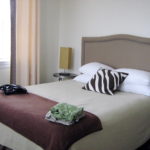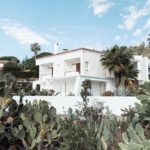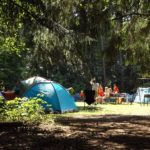Every now and then the whitewashed town would appear before us as we approached on the winding road from Llançà, and as we got closer we realised Port de la Selva really was something quite special.
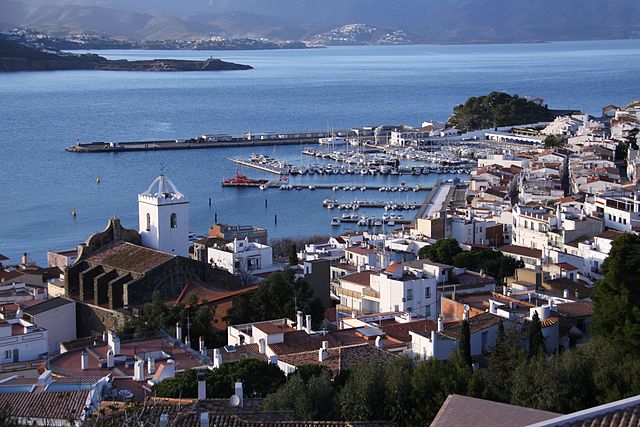
Looking down on El Port de la Selva. Photo by Jean-Pierre Bazard.
We’d been recommended Port de la Selva as somewhere to spend a week with some piece and quiet. But we hadn’t expected the Costa Brava to actually provide somewhere quite as sleepy as this fishing village to the north of the Cap de Creus.
The area surrounding it is a protected park, as is much of the sea, and it provides a stark beauty that cannot be matched. The water is a bit cooler than further south, but it is also exceptionally clear. Whether you like beaches or rocky coves, there are plenty of places to swim or snorkel.
In fact, we so fell in love with the place that we went back there every year between 1998 and 2012, extending our holiday first from a week to 10 days, and then to the last fortnight of August each year.
About Port de la Selva
El Port de la Selva is a former fishing village on the north of the Cap de Creus that remains relatively unspoilt. That’s despite many private residences having been constructed immediately around the nucleus of the original town and between the town and Llançà.
The town sits on the boundary of the Cap de Creus natural park, where it is completely prohibited to build, and the area’s stark beauty is sometimes highlighted by the mighty tramuntana that blows the cold off the Pyrenees.
The water up here is noticeably colder than further south, but also often particularly clear. Port de la Selva is also something rare in that it is a quiet Costa Brava seaside town and although you will get kids on mopeds whizzing around the streets and a bit of noise when the discos close at weekends, it is remarkably quiet.
You can zoom in or click on the icons for more infoThe first record of El Port de la Selva dates back to 974, but it appears not to have been occupied prior to the construction of the church in the 18th century. The first houses were for fishermen who lived in nearby Selva de Mar and other villages and in 1787 it became a village in its own right, distinct from Selva de Mar.
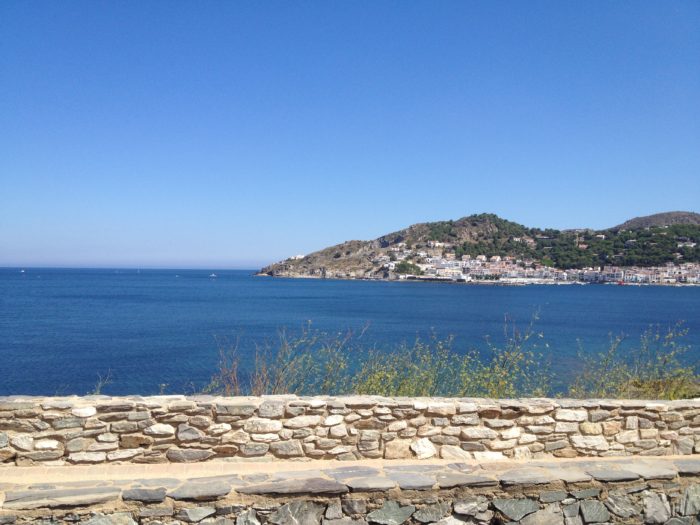
Port de la Selva from the mirador
Along with fishing, the other main industry was olive oil and wine, with the hills surrounded in vines. However, the phylloxera epidemic that stuck much of the Costa Brava in the second half of the 19th century resulted in a mass exodus as families were no longer able to earn a living from wine.
In the 1920s the town started to become popular with the Catalan intellectual set, but it was not until the 1960s that tourism overtook fishing as the town’s principal source of income and so began the construction of tourist homes and urbanisations in the town and surrounding area. The last official figures, dated 2010, show the population as less than a thousand inhabitants.
Beaches
The main beach is around 500 metres long and just off the promenade. With a limited population in Port de la Selva even in August it rarely gets too crowded. Many of the houses are owned by wealthy Catalans and remain empty during much of the summer, although more people travel up from Barcelona and Girona at weekends when it is noticeably busier and harder to park.
The sand on the main beach is a rather fine consistency and towels quickly get caked in it, but it is ideal for families as the slope is very gentle. If you swim out to the buoys marking the edge of the swimming zone it is a few metres deep, so you get the best of both worlds.
There are a number of much smaller beaches nearby too, although these all tends to have pebbles rather than sand. Tamariua is actually just within the Cap de Creus natural park and although a little difficult to park and then to walk, it remains popular with many people. It is also popular with nudists.
The beach at one point had a xiringuito offering cold drinks and snacks, accompanied by the constant hum of a diesel generator, but thankfully that lasted just one or two summers. The steps down to the beach are a little steep, but have also been improved over the years from what they once were.
There are a number of beaches and coves between the town and Tamariua, and in the direction towards Llançà too, many of which are excellent for snorkelling.
Where to stay
Although there are hotels, hostals and campsites, the majority of Port de la Selva accommodation is privately owned.
But while many houses and apartments lie empty for most of the summer, there are also many holiday homes available from local letting agents or online.
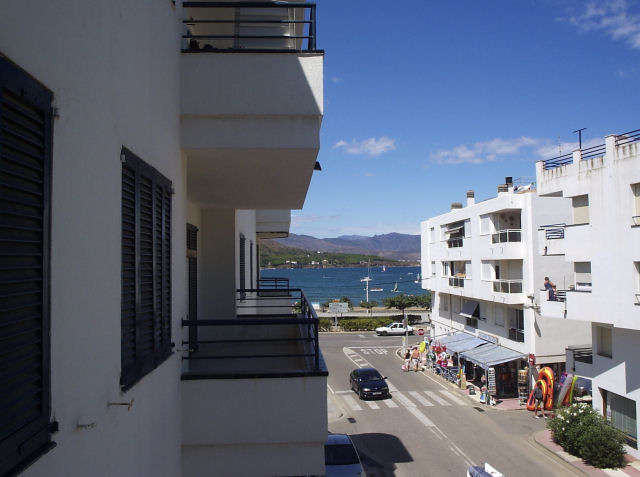
Apartment balcony in Port de la Selva. Photo by David Leigh.
Many are used by the owners off season, particularly during weekends in the spring and autumn. Owners let them during the summer to help towards the cost of owning a second home.
Holiday rentals
Privately owned accommodation available for rent in Port de la Selva ranges from lovely old fisherman’s houses to purpose built holiday apartments. At the top end you’ll find large houses overlooking the sea from high in the hills.
We always stayed in holiday apartments, which are fine for the summer, but not really designed for winter stays as they have no heating. It can get really cold off season!
The main issues we’ve had are the noise from neighbours and lack of hot water. The noise is simply because the walls are thin and so sound carries easily. The lack of hot water is due to the small cylinder size, although we once had the hot water cylinder pack up on us while on holiday requiring a replacement to be fitted while we were there.
Our first accommodation was a studio apartment, which was fine for everything but the shower. It was so small it was easy to knock the hot water full on with your elbows. We both managed to scald ourselves multiple times!
Some apartments will have a balcony with a sea view, however limited that view might be. See the photo at the top of the page. But others may have
Hotels
There are also a small number of hotels in Port de la Selva, variously classified as hotels, hostals and pensions. The essential difference between them is that a hostal – not to be confused with a hostel – is more likely to be a family run business than a hotel, while a pension offers budget accommodation with shared bathrooms.
I have stayed in a hotel in Port de la Selva, but it was many years ago and they knocked it down! They built private apartments there instead.
Campsites
There are three campsites in or just outside Port de la Selva. The small Camping L’Arola lies on the edge of town right next to the sea right next to the hostal of the same name. It is fairly basic but perfectly positioned if you prefer to stay next to the sea. Camping Port de la Vall lies just behind the beach of the same name, in a valley between Port de la Selva and the lighthouse. And Camping Port de la Selva is just off the road to Cadaqués.
Restaurants
If you want fresh seafood and don’t mind paying for it then Ca l’Herminda is probably where you should head. There are a quite a number of restaurants with a focus on seafood, but there are a number of pizzerias too.
Monterrey is near the centre of town and has a glasshouse to protect guests from the elements, but if you are able to get an outside table in summer the food is worth it and the Cafe del Pósit, also nearby, is good for lunchtime tapas and a beer. Ca La Paquita right net to the fish market is also a good bet as is the restaurant of Hotel Cal Mariner. The latter specialises in traditional seafood dishes and has a large terrace with views of the sea and mountains.
What to see and do
Apart from swimming and sunbathing there is plenty more to do. Many of the coves are ideal for snorkelling and you can see plenty of fish and other sea life here, especially when the water is clear. A particular highlight one year was watching a cormorant swimming underwater looking for fish while I was snorkelling. That felt like a true privilege.
The area is good for walking too, with a coastal path that runs to Llançà and up in the hills above is the monastery of Sant Pere de Rodes. You may want to spare yourself the long walk up there and drive though. You can also walk in the natural park, but do carry water with you as there are no facilities there. There are numerous hiking trails and the scenery is stunning. From Port de la Selva you can hike to Cadaqués, exploring the various coves in between as you go and stopping off for a dip to cool off.
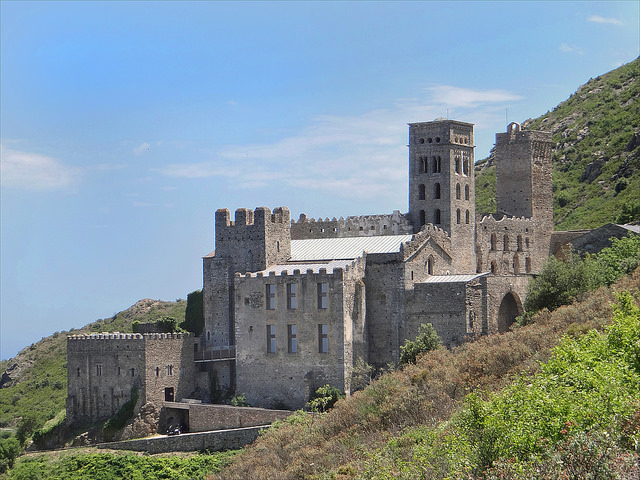
Sant Pere de Rodes monastery. Photo by Jean-Pierre Dalbéra.
The town has a dive centre with shop and the boat usually sets off to one of a number of dive sites on the Cap de Creus twice a day in high season. Unlike many dive centres the boat goes out even when the tramuntana is blowing strong, when it gets extremely choppy. But with often exceptionally clear water, some with large groupers, it is an excellent location for divers. Another dive centre operates in Llançà and has boat excursions in the mornings.
There are also numerous other water sports, such as windsurfing, water skiing, jet skis and a marina where you can moor you boat. Most boats here are small sailing boats, although the super rich sometimes moor their gin palaces off shore here too.
How to get to Port de la Selva
El Port de la Selva is 33 kilometres from Figueres and 70 from Girona. It can be reached by the winding coastal road from Llançà or through the even more winding roads through the Cap de Creus natural park via Castelló d’Empúries. Sarfa runs a bus service there too, although it is quite limited of you plan on spending just a day there.

